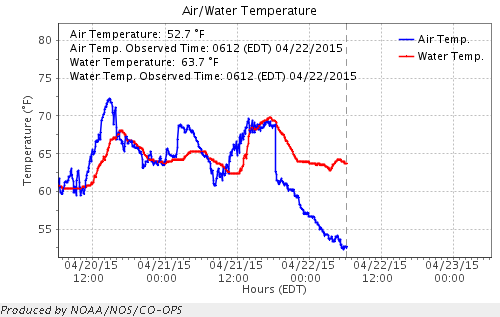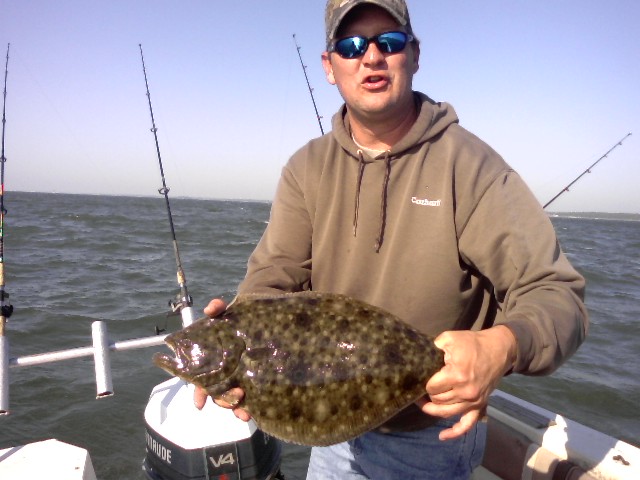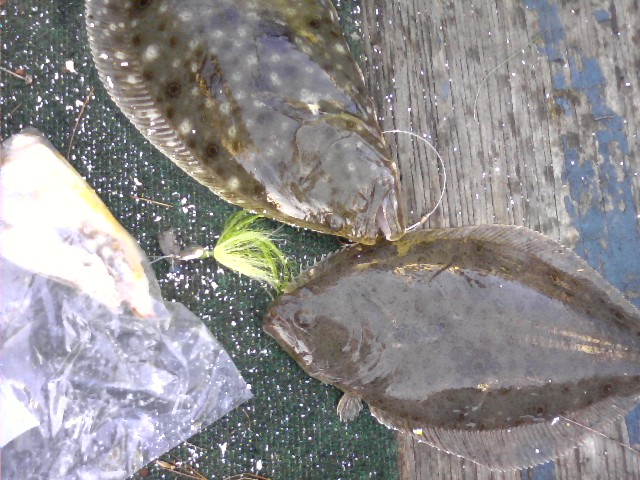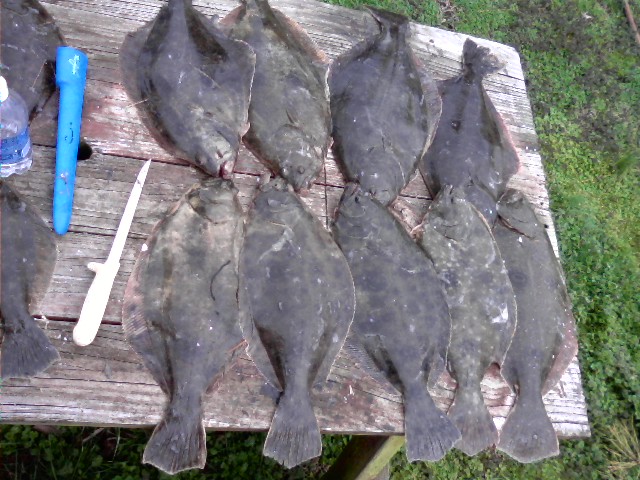
22 Apr Sprintime flounder fishing
Flounder fishing is an eastern shore spring tradition. Wachapreague, Virginia boasts that it is the flounder capital of the world, and for good reason. Every spring, starting in mid march or early April, flounder fishermen flock to the little town to try to catch their first saltwater fish of the year. The action starts on the lower seaside bays and creeks of Virginia. The fish first show up in Quimby and Oyster, and a week later in Wachapreague and the mouths of Parkers and Follys creek. Two weeks from there you can find fish steady in Chincoteague assuming the wind lays down a few days. This is followed by another week or two for good fishing in Ocean city up through Delaware. Years ago there was a season that did not start until April 1st, and it seems that on opening day you could find fish fairly steady as north as Metompkin Bay. In 2012 we had a very warm spring and reports of fish out of Oyster came in the last days of February.

Water temperature plot of Wachapreage Viirginia
Water temperatures are the key to finding this fish in the early season. Noaa’s National Buoy Data Center releases tidal and water temperature data online in a plot format. There is a station in Wachapreague called WHAV2 LINK HERE Assuming we have a warm spring, I start watching their website every few days and looking at the trend in water temperature and tides. You are looking for days when the temps go above 50 degrees and days when the water will be clear, not after a rain. The strong temperature rises will start happening in the afternoons of sunny days when there is an outgoing tide. The Wachapreague station read a bit higher than the surrounding waters because it is so far inland, but it gives you a great idea on when you want to be fishing. The golden rule of early spring flounder fishing is a falling tide on the afternoon of a sunny day which pushes the water temps to 55 or so. Now, with that said, I do not follow this rule. If temps are hitting 55 most afternoons I make sure I am fishing first thing in the morning. I like to be launching the boat by 7am at least and fishing soon after. Most of the times the water is around 48-50 and will warm a few degrees regardless of the tide when the sun comes up. Flounder are very sight oriented feeders and I have never caught them at night (without a spear and light). This leads me to believe that when they wake up can can see, they are hungry. Most all of my best early spring flounder trips have done better in the early morning until lunchtime. This time of day the wind is also not as strong. Many an expert flounder fishermen will completely disagree with this theory, read this idea in disgust and will not take the boat out until the afternoon. They do catch fish, but I like to get my fishing done early and have the afternoon free (a good time to surf fish for stripers and drum)
Another golden rule for flounder fishing is drifting, and I have not done it in many years and have better success than when I used to drift. I was taught to troll for flounder by a local fisherman that would always bring home big catches of fish and was known to be able to catch a flounder in a ditch. Being a wharf rat, I soon made friends with this guy and finally got the offer to go fishing. From an old, tattered, leaky aluminum boat I watched as he laid out a spread of 10 rods while keeping the motor runnin and in gear. The spread was large enough to make a tuna fisherman nervous of a tangle. I kept watching and he would tell me to drop one back a bit or crank one in a few cranks until all lines were staggered, all the while the boat kept chugging along at 1.2 knots. Even through tight turns those lines would run true and not tangle, his secret, don’t touch a rod until you have straightened back out. Every morning he would have to pull 2 spark plugs and swap them in that little Johnson 70 seahorse just to make it run right, then he could fish it all day, idling slower than any other 2 stroke I have seen. What swapping those plugs did I still have no idea. He would always troll with the tide, against it and your sinkers do not bounce on the bottom correctly. I took many trips on that old boat, and it seemed like we would catch fish, a lot of fish, on each trip. Some might say it was the 10 rods, but I know it was the trolling.

You need a lot of rod holders to troll for flounder
The secret to trolling is the ability to cover ground and work productive areas. There are now a number of boats who fish this method in the flats of Chincoteague in 3 to 7 ft of water. You can tell they are trollers as their boat drives in large slow circles like that of the old crab drudgers of Greenbackville working their crab scrapes. The first trolls of the morning are to find the fish, mainly in a straight line, marking the gps when you catch. Flounder like to stack up tight, not as tight as on offshore wrecks, but when you find one there are usually more. In the flats, the tide is not as strong and you can work both ways of a tide, but fishing with the tide is almost always more productive. A key is to find good clear water, if its muddy, it is going to be tough fishing. Some of the best days I have had you can see the bottom when you are in 3.5’ of water. When you hook a fish mark the location and go a bit further and if no more bites make a swing to come back around on that area. By doing this you can get a good idea where the fish are laying.
Fishing a creek or channel is a different method where you have to keep the boat “crab walking” along the productive area. This means a dedicated person on the wheel and motor the entire time. You have to account for the wind and the tide and the channel below you. First you must know the way the channel runs, then the way the wind and tide push your boat in reference to the channel. The goal is to set the bow at an angle that matches the opposite angle the wind/tide have against the channel. By doing this, as the wind/tide force pushes you off the channel, you can bump your motor in gear and push back over the channel. This does take much practice, but once you master this technique you can crab walk the boat right down a channel ledge at the specific depth of your choice regardless of the wind and tide. Doing this, your lines will never go straight out of the back of the boat, but off to one side or the other, this is normal and as long as they are all doing the same thing, they should not tangle.

a couple early spring flounder on a bucktail
Trolling for flounder is done both on the seaside and bayside, and even in the ocean, but depths over 40 feet it gets difficult to keep baits down and separated. Aside from keeping the boat over the productive area, the most difficult part is keeping your speed right. The goal is 1.2knots. You can catch fish from .8 to 2 knots but 1.2 -1.4 is the most productive. You want a good steady bounce from all of your rod tips, and most of the time the right speed can be found without even looking at the gps speed. I have never owned a motor that could idle as low and slow as that old Johnson 70, so my technique is bump trolling. It requires a lot more work by the captain and it sure does work your throttle cables. If I leave my engine in gear at the lowest idle, it pushed my boat along around 3 knots which is too fast. I have to bump the boat into gear for 5-8 seconds, then pull pack out for 20 seconds. This may sound like a lot of work, and it is, but it is also productive. Some boats will pull 5 gallon buckets or sea anchors to slow down, to me these just get in the way of a hooked fish.
While the trolling techniques are extensive above, the rigs I use are quite simple. I normally fish a spread of 5 or 6 rods with a regular top and bottom rig on each. Many good flounder anglers like a long leader (>24”) but i prefer to use shorter versions. I will usually have 2 or 3 baits with the typical bucktail/spinner/3/0 or 4/0 kahle hook on the top dropper, no more than 18” long and then a plain hook on the bottom.the same length. I feel that longer leaders drag the ground and pick up grass (called slur) and any hungry flounder will gladly swim up to two feet from the bottom to grab a bait. Every color bucktail under the sun is sold, but you will only see pink or white in my tackle box, and both with a strip of mylar if I can find it. The other rods I will use plane kahle hooks, or a hook with single red bead. You must take care in casting these rigs to make sure the top hook does not wrap up in the leader, if it does, reel in and do it again. I say to cast because it makes it easy to stagger your trolling lines, some far back, some in close, and match one side of the boat with the other.
As with rigs, there are many different baits for flounder inshore. I have one friend that will not leave the dock unless he has cleaned squid, whole squid, silversides, minnows, smelt, fish bites, gulp and bottle of some catfish squirt juice. Unlike my overly prepared friend, I use two baits for inshore flounder fishing, live large bull minnows and strip baits. Now, I have done my share of jigging gulp and it is productive, but it is not very practical for trolling (mostly because I am driving the boat and don’t have 3 hands). There are two ways to rig a bull minnow to a kahle hook, through the lips and through the eye socket. I always use the lip method, I think it keeps the fish alive a bit better and swimming straight. Other anglers use the eye sockets saying it’s harder for the fish to pull the minnow off the hook on a short strike, both methods do work. Strip baits can be made from a variety of fish bellies include dogfish, bluefish, large croaker, but the best is from the underside of another flounder. Using a sharp knife, take the underside of a flounder and cut 1” wide strips from behind the pectoral down to the tail, tapering each to a point at the tail, now cut around the fillet and the cut each triangle piece out, they should be 4” to 8” long. Each strip should look like a triangle, if you take a pair of scissors you can cut the flat end of the triangle into a shallow point, this is where you will hook the bait. Run the hook through the bait only once at the shallow point end, about ¼” deep. It is important to test your bait in the water to make sure it does not spin. A spinning bait will not catch fish, the strip should flutter in the water.

A nice catch of early spring flounder. Now this is the start of a fine dinner.
So by now you’re all geared up, trolling along with good baits, rod tips are bouncing along, how do I know if its the bottom or a fish? This is determined by nothing but practice. Many a new angler will grab a rod when it hangs up just a bit in the bottom, snatch back and nothing. After paying careful attention, it becomes easy to tell the difference between a small snag, the bottom and a fish hanging on. Begin by watching each rod, they all pull down at the same speed and bounce back at the same speed. Also note, they all bounce back to the same level every time with the same amount of curve in the tip. The speed that the tips drop when bouncing on the bottom is proportional to the speed of your boat over the bottom. A fish will make the rod tip dip and not return back to its normal spot. This is important to watch, a rod tip that is not in its normal position either has a fish hanging on or some “trash” on the line (seaweed, slur, oyster shells etc.)
Flounder do not bite like other fish, many times they will swim up and just hold on to the tail your bait and keep swimming along with the weight of the fish hardly noticeable to the angler. I have seen fish that will hang on like this for 20 yards before turning or trying to return to the bottom. When you see the rod tip bent over just a bit further than it should be and it is not bouncing like the rest of your rods, it’s time for the drop back technique. The angler should carefully pick the rod from the holder with as little movement of the tip as possible, flip the bail (or go free spool on a baitcaster) and let the line go slack. Give the flounder about a 5 second count, then flip the bail. At this point, do not snatch back like you’re setting the hook on a freshwater bass, but reel up the slack almost tight and then lift the rod fairly swiftly. You should feel pressure, and its fish on! A net is mandatory for flounder fishing, I can’t count the number of fish I have personally lost at the side of the boat trying to lift them over.
So there you have it, spring is here, go get em!




No Comments